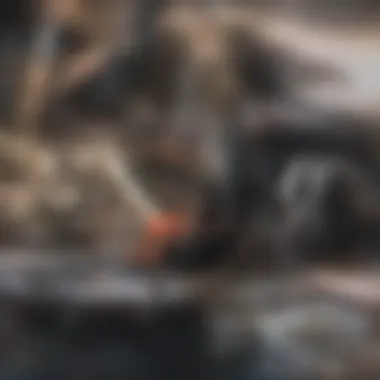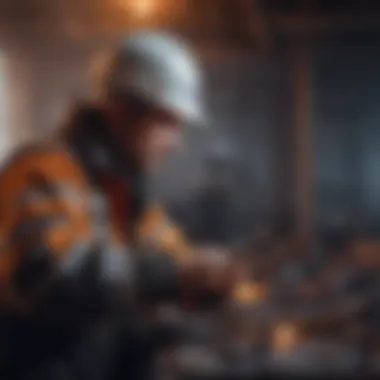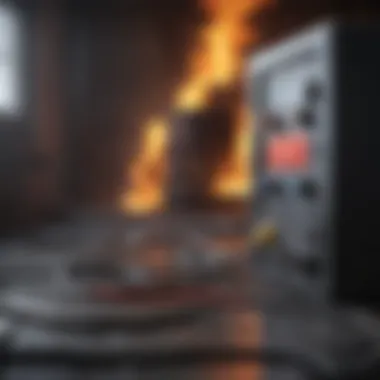Critical Steps for Electrical Inspection After Fire


Intro
Electrical inspections after a fire incident are often overlooked yet crucial for maintaining safety and ensuring compliance. When a fire occurs, it can cause extensive damage to the electrical systems in a property, posing a risk of further hazards such as additional fires or electrocution. Understanding the steps necessary for a thorough inspection is essential for homeowners and business owners alike. Not only does this evaluation protect people and property, it also aligns with legal requirements and insurance policies.
The importance of systematic evaluations cannot be overstated. These post-fire inspections focus on identifying fire damage, assessing system functionality, and determining compliance with safety regulations. Professional inspectors bring the expertise needed to navigate the complexities of electrical systems and ensure that everything is in working order. This comprehensive approach not only safeguards life and property but also supports future prevention strategies.
Furthermore, the relationship between insurance coverage and electrical inspections highlights the need for proper documentation and assessments. Homeowners and business owners must be aware of their coverage options and the specifics of their policies to effectively manage risks after a fire incident. Understanding what is covered, what is not, and the limits of these policies provides clarity and peace of mind.
As we delve into the critical steps and considerations necessary for thorough electrical inspections after a fire, it is essential for all stakeholders to recognize the weight of these assessments.
Coverage Options
Types of Coverage Available
After a fire, knowing the types of insurance coverage available is vital. Typical options include:
- Homeowner’s Insurance: This generally covers damage to the structure of the home and personal belongings.
- Business Interruption Insurance: This helps cover loss of income due to the fire causing operational downtime.
- Liability Coverage: Protects against claims from third parties who might get injured on the property due to electrical issues post-fire.
Understanding these coverages can help homeowners and business owners select the right policies to protect their interests adequately.
Liability Coverage Explained
Liability coverage is crucial in most insurance policies. It offers protection in the event that someone is injured or experiences loss due to your property, including fire-related incidents. This means that if a fire weakened the electrical system and led to an injury, your liability coverage would help manage the legal and financial repercussions.
When selecting liability coverage, consider the limits prescribed by your insurer. Higher limits may mean higher premiums, but also greater protection. Always assess your specific needs against the potential risks, informed by a thorough inspection after any fire incident.
Key Considerations
Factors to Assess When Choosing Insurance
When reviewing insurance options after a fire incident, consider the following:
- Property Value: Ensure that your coverage reflects the current market value of your property.
- Replacement Costs: Look for policies that cover replacement costs rather than actual cash value, which subtracts depreciation.
- Operational Needs: For businesses, assess what coverage ensures continuity during recovery.
Understanding Policy Limits
It is equally important to understand the limits and exclusions outlined in your insurance policy. Many policies may have specific stipulations regarding fire damage. It can be wise to consult with an insurance agent to clarify terms and ensure adequate protection moving forward.
Understanding Fire Damage and Its Implications
Understanding fire damage is not merely an academic exercise; it is a crucial element in ensuring safety and compliance after a fire incident. The significance of analyzing the nature of fire damage lies in the potential risks that electrical systems pose post-fire. A thorough review of this damage can reveal the current state of these systems and dictate the necessary steps for repair or replacement.
Nature of Electrical Fires
Electrical fires occur due to failures in the electrical system, leading to ignition. These failures can manifest in various forms such as overloaded circuits, faulty wiring, or even equipment malfunctions. The nature of electrical fires often involves hidden damage that is not immediately visible. This hidden aspect makes it imperative to conduct assessments that go beyond superficial observations. Fires can start from various elements like frayed wires or circuit board issues. Knowledge about these elements can aid in identifying potential hazards during an electrical inspection.
Common Causes of Electrical Fires
To prevent future incidents, it is essential to understand the common causes of electrical fires. These causes include:
- Overloaded circuits: When too many appliances draw electricity from a single circuit, overheating can occur.
- Faulty wiring: Old or improperly installed wiring can deteriorate and become a fire risk.
- Appliance malfunction: Appliances that are defective or not maintained can spark fires.
- Improper use of extension cords: Misusing extension cords can lead to overheating. Recognizing these causes can help in developing preventive measures that mitigate risks and ensure stronger electrical safety.
Impact of Smoke and Heat on Electrical Systems
Smoke and heat can severely affect electrical systems after a fire. The corrosive composition of smoke can infiltrate devices and connections, leading to long-lasting damage. Likewise, heat can cause insulation to melt and components to warp.


When evaluating the electrical system post-fire, it is crucial to analyze not only the visible damage but also the hidden risks introduced by smoke and heat. Inspectors must look for:
- Burn marks: Signs of prior fire incidents indicate risk zones.
- Smell of burnt materials: Distinct smells can reveal affected devices.
- Deterioration of insulation: Insulation loss can lead to short circuits.
The Importance of a Post-Fire Electrical Assessment
After a fire, it is crucial to conduct a thorough electrical assessment. Electrical systems may suffer damage that is not immediately visible. This damage can pose serious safety risks. A post-fire assessment helps identify hidden dangers and potential hazards.
Safety Concerns for Occupants
The safety of occupants is the primary concern after a fire incident. Faulty electrical systems can lead to further accidents, such as electrocution or even another fire. For instance, damaged wiring may still carry current, leading to dangerous situations. Furthermore, smoke and heat from the fire can compromise the integrity of electrical components. Inadequate assessment may leave families and employees vulnerable. A thorough inspection ensures that all systems are safe before reoccupation. This is not just best practice; it is necessary for safeguarding lives.
Legal and Regulatory Compliance
Addressing legal and regulatory aspects is another critical component of post-fire electrical assessment. Different jurisdictions have specific codes governing the repair and replacement of electrical installations. Compliance with these regulations protects property owners against potential liabilities. A lack of adherence to building codes may result in fines or increased insurance costs. Additionally, insurance claims often require evidence that safety inspections were conducted as per legal standards. Therefore, having a clear record of the inspection and compliance is vital for anyone involved. It serves to highlight that the owner took all necessary steps to ensure safety.
The necessity of evaluating electrical systems after a fire cannot be overstated. Not only does it protect human life, but it also safeguards assets and complies with crucial regulations.
Conducting a Thorough Electrical Inspection
A thorough electrical inspection is crucial after a fire incident. It ensures the electrical systems are safe and operational post-fire. This inspection prevents future hazards, identifies potential risks, and highlights necessary repairs. Conducting a structured assessment provides peace of mind to property owners, whether in residential or commercial settings. The objective is to restore electrical functionality without compromising safety.
Step-by-Step Inspection Process
Visual Examination of Electrical Panels
The visual examination of electrical panels serves as one of the first steps in the inspection process. Inspectors check for any physical signs of damage such as charred components, discoloration, or corrosion. Identifying these characteristics is essential for determining if the panel is still functional.
This method is popular due to its efficiency. It offers immediate insight into potential issues without extensive equipment. However, while visual checks are beneficial, they do not always reveal hidden problems. Relying solely on this step could overlook deeper electrical failures.
Testing Circuit Functions
Testing circuit functions is another essential aspect of post-fire inspection. This step involves using specialized tools to assess the operational status of circuits. Working circuits indicate that the electrical system may still be intact despite fire exposure.
This process is effective for identifying faults that could lead to future electrical fires. It is beneficial because it evaluates the performance under load, revealing any weaknesses. However, this approach requires skilled technicians, as incorrect testing can lead to misdiagnosis.
Checking Wiring Integrity
Wiring integrity is critical after electrical inspections. Inspectors examine wires for insulation damage and signs of wear. This step is important because compromised wiring can pose fire and shock hazards.
The uniqueness of checking wiring lies in its ability to uncover issues not visible during a visual examination. This inspection adds depth to the overall assessment. However, the challenge here is that most wiring damage can only be detected through invasive methods, which may not always be feasible.
Utilizing Technology in Inspections
Incorporating technology has transformed electrical inspections. Advanced tools provide more detailed evaluations than manual inspections.
Infrared Scanning
Infrared scanning is becoming a common practice in post-fire inspections. This technique allows inspectors to visualize heat patterns in electrical systems, identifying overheating components that could lead to future failure. The primary contribution of infrared scanning is its ability to detect issues without dismantling equipment.
Its high effectiveness and non-invasive nature make it a valuable choice. Yet, such technology requires trained personnel to interpret the results correctly. Misinterpretation could lead to premature action or overlooking other critical factors.
Multimeters and Testing Equipment
Multimeters and other testing equipment are vital for assessing the electrical functionality during inspections. These devices measure voltage, current, and resistance, providing insight into circuit integrity and performance. This equipment is essential for thorough investigations after the fire.


Multimeters offer precise data, which can lead to more informed decisions regarding repairs. Their unique feature lies in their versatility, allowing inspectors to test multiple circuits with one tool. However, not all technicians are adept with this equipment, and improper usage can yield inaccurate results.
Conducting a thorough electrical inspection is foundational to ensuring safety and compliance after fire damages. It is not just about assessing damage but also preparing for future protection.
Engaging Professional Electrical Inspectors
Engaging a professional electrical inspector after a fire is a crucial step toward ensuring safety and compliance. Fires can cause extensive damage not only to the property but also to the electrical systems that may appear intact at first glance. A thorough inspection by a qualified professional can uncover hidden hazards, ensuring that all systems are functioning correctly and safely.
Professional inspectors bring expertise and a systematic approach to evaluating electrical systems. Their knowledge of local codes and regulations helps guarantee that all repairs adhere to legal standards. Relying on an expert reduces the risk of overlooking damage that could lead to future incidents, thus protecting both life and property long-term.
Criteria for Choosing an Inspector
When selecting an electrical inspector, there are key criteria to consider that can significantly influence the quality of the inspection and the safety outcomes.
Qualifications and Certifications
Qualifications and Certifications play a vital role in the competency of an electrical inspector. Licensed inspectors often have undergone rigorous training and testing, which equips them with the necessary skills to assess electrical systems post-fire. A trusted characteristic of these qualifications is the influence they have on insurance claims and liabilities. Many insurance companies prefer inspectors with verifiable credentials when processing claims.
Additionally, unique certifications may indicate specialized training in fire-damaged properties, enhancing the inspector’s ability to identify nuanced issues. For example, certifications from organizations like the National Fire Protection Association demonstrate a commitment to upholding high standards in fire safety. This adds a level of assurance that the inspection is thorough and reliable.
However, it is essential to verify that the certifications are current. Outdated qualifications can be a disadvantage. Always ask about the latest training and ensure that the inspector is familiar with current codes and practices.
Experience with Fire Damage
Experience with Fire Damage is another essential consideration when choosing an electrical inspector. Inspectors who have dealt directly with fire-damaged properties possess firsthand knowledge of the potential consequences fire brings to electrical systems. Their familiarity with typical issues—such as short circuits, burned wiring, or compromised connections—can be invaluable in identifying risks during inspection.
A significant feature of seasoned inspectors is their ability to provide informed recommendations based on similar cases they have handled. They can offer a nuanced perspective on repairing or replacing damaged components, which is beneficial for property safety. However, the downside can be finding inspectors with extensive experience since they might be in high demand, leading to longer wait times for service.
Costs Associated with Professional Inspections
While the costs of engaging a professional electrical inspector may vary, it is crucial to view this expense as an investment in safety. Several variables can affect pricing, including:
- Location of the inspection
- Size of the property
- Extent of fire damage
- Inspection time required
Understanding these factors can help property owners prepare for potential expenses. Though cost may seem high, it is often cheaper than the expenses associated with inadequate inspections that might result in further damage or even dangerous situations down the road. Investing in a thorough inspection safeguards against future issues, making it a wise choice for peace of mind.
Potential Outcomes of an Electrical Inspection
After a fire, the potential outcomes of an electrical inspection play a crucial role in the recovery process. Inspections may reveal significant damage or, in some cases, show that electrical systems are still functional and safe to use. Understanding these outcomes can lead to informed decisions regarding repairs, replacements, and preventive measures for the future.
Repair Recommendations
In many instances, an inspection post-fire will highlight areas of electrical systems that require repair. Professionals may well find damaged wires, malfunctioning circuit breakers, or compromised outlets. Repair recommendations are essential to restore safety and functionality to the electrical system.
Homeowners and business owners must consider these recommendations seriously. Delaying necessary repairs can lead to more extensive damage and safety hazards. Some common repair suggestions include:
- Replacing damaged wiring: Fire can cause insulation to melt and wires to short-circuit, necessitating immediate replacement.
- Repairing or replacing circuit breakers: If the breakers are tripped during the fire, they may need to be changed to ensure reliable operation.
- Fixing outlets and switches: Outlets that show signs of burning, charring, or melting should be replaced to prevent future issues.
Implementing these recommendations not only enhances safety but also helps in complying with local building codes and insurance requirements. Having comprehensive documentation of repairs can also aid in any future insurance claims related to fire damage.
Replacement Scenarios
In more severe cases, the inspection may indicate that entire systems or significant components need replacement. Understanding these scenarios is vital for anyone navigating post-fire recovery.
- Full System Replacement: If the electrical system has sustained extensive damage, replacing the entire system may be the only viable option. This often occurs when the main electrical panel, service drops, or extensive wiring networks are compromised.
- Major Component Replacement: Sometimes, specific components may not function properly. For example, if an electrical panel is outdated and damaged due to heat, it might need complete replacement.
- Aging Systems: Properties with older electrical systems may face additional scrutiny. If fires reveal that the system is not up to current codes, replacements may be required to ensure safety.


In all cases, ensuring a certified electrician oversees replacements is crucial. This helps to maintain compliance with safety standards and local regulations and safeguards investments in property and equipment. Repair and replacement outcomes guide not only immediate action but also influence future fire safety measures.
Preventive Measures to Avoid Future Electrical Fires
Preventive measures to avert future electrical fires are essential for safeguarding lives and property. Fire incidents can result in substantial damages, and the aftermath may lead to significant repair costs and emotional distress. Hence, establishing effective preventive strategies can greatly reduce the risk of fire recurrence and enhance safety within homes and businesses.
Regular Inspection Routines
Regular inspection routines form the backbone of an effective fire prevention strategy. Establishing a schedule for electrical inspections can help identify potential hazards before they escalate into a fire. Consider the following aspects:
- Frequency of Inspections: Depending on the age of the electrical system and its usage, inspections should be conducted at least once a year or more often if there are significant changes in electrical load or after any renovations.
- Qualified Electricians: Engage licensed professionals with experience in electrical systems. Their expertise is invaluable for recognizing wear and tear, outdated components, or systems that are not compliant with current safety standards.
- Documentation of Findings: Keep thorough records of each inspection. Document any identified issues, actions taken, and recommendations for improvements. This serves as both a reference for future inspections and a compliance record if needed for insurance purposes.
Maintaining a regular inspection routine not only aids in identifying potential fire risks but also fosters a culture of safety within the environment, reinforcing awareness about electrical hazards.
Educating Occupants on Fire Safety
Education on fire safety is a pivotal preventive measure. All occupants, whether in a residential setting or a workplace, should be well-informed about the principles of fire safety. This can significantly elevate the collective preparedness for managing emergencies. Here are critical elements to consider:
- Understanding Electrical Safety Practices: Occupants should be taught how to safely use electrical appliances and recognize signs of malfunction. Simple practices, such as avoiding overloading circuits or using extension cords responsibly, can be effective in preventing hazards.
- Emergency Preparedness Training: Conduct sessions that include fire drill practices, emergency exit routes, and the proper use of fire extinguishers. Knowledge on how to react during a fire can save lives.
- Regular Updates: Safety training should be refreshed periodically. As new products and technologies emerge, it is essential to update occupants on current safety protocols.
Investing time in educating occupants can create a safer environment while fostering a sense of responsibility towards fire safety. Overall, implementing these preventive measures will contribute significantly to minimizing the risk of electrical fires, ensuring both safety and peace of mind.
Insurance Considerations Following a Fire
After a fire incident, addressing insurance matters becomes a critical step for both homeowners and business owners. Understanding the implications of insurance can lead to more effective recovery, ensuring that financial burdens are manageable. It is important for individuals to grasp how their insurance policy functions in the aftermath of a fire, particularly regarding repair costs and damage documentation.
Role of Insurance in Repair Costs
Insurance serves a vital role in funding the repairs necessary after a fire. Policies vary, but many cover damages related to structural repairs, replacement of personal belongings, and sometimes even temporary housing costs. Homeowners and business owners should review their policies closely to identify the coverage limits and any deductibles that may apply.
In many cases, the insurance company will send an adjuster to assess the damage. This assessment is crucial, as it influences the claim outcomes. Understanding what damages are included and excluded from coverage can help in forming realistic expectations for the claims process. Key points to consider include:
- Dwelling Coverage: This typically covers the structure of the home or business, including electrical, plumbing, and HVAC systems.
- Personal Property Coverage: This can help replace personal items that were damaged in the fire.
- Additional Living Expenses: If the property becomes uninhabitable, some policies may cover extra living costs.
Clear communication with the insurance adjuster about which repairs are most urgent can speed up the approval process. However, one should also be prepared for potential disputes over the value of damages claimed.
Documenting Damage for Claims
Documentation plays a critical role in the claims process. Properly recording damages can significantly influence how much compensation will be received. Here are the essential steps to document damage effectively:
- Take Photographs: Capture detailed images of the fire damage from various angles. This provides clear evidence for the insurance company.
- List Damaged Items: Create a thorough inventory of all damaged items, including electrical appliances and infrastructure. Include descriptions, original costs, and estimated replacement costs.
- Get Repair Estimates: Obtain estimates from licensed professionals to repair or replace damaged electrical systems and other affected areas. This helps in establishing a realistic value for the claim.
- Keep Receipts: If any expenses accrue before the claim is finalized, such as emergency repairs, keep the receipts for reimbursement consideration.
It is advisable to file the claim as soon as possible, providing all the collected documentation promptly. Delays in reporting can complicate the claims process and may even risk denial of the claim.
"Effective documentation and communication are paramount to achieving a satisfactory outcome in insurance claims post-fire."
Culmination and Final Thoughts
In the aftermath of a fire, the role of electrical inspections cannot be overstated. Ensuring the safety of inhabitants and the structural integrity of properties is paramount. The complexities of electrical systems often require a detailed examination. This is crucial not only for immediate safety concerns but also for long-term risk mitigation.
The Bottom Line on Electrical Safety after Fire
Electrical safety post-fire involves several key considerations. First, the inspection process needs to identify any compromised wiring or appliances that could pose further hazards. The aftermath of fire can leave hidden damage that might not be immediately apparent. A comprehensive assessment helps uncover these issues.
Key benefits of a thorough inspection include:
- Preventing Hazards: Post-fire electrical systems can maintain dangers like shorts or fires. Addressing these risks is essential.
- Regulatory Compliance: Many local laws demand inspections after such incidents. This compliance protects property owners from potential legal consequences.
- Insurance Verification: Proper documentation resulting from inspections can greatly assist during claims processing. This ensures that homeowners or business owners are fully covered for damages.
"The hidden effects of fire on electrical mechanisms can only be fully understood through a comprehensive inspection."
Therefore, addressing these aspects is an investment in safety and security.



